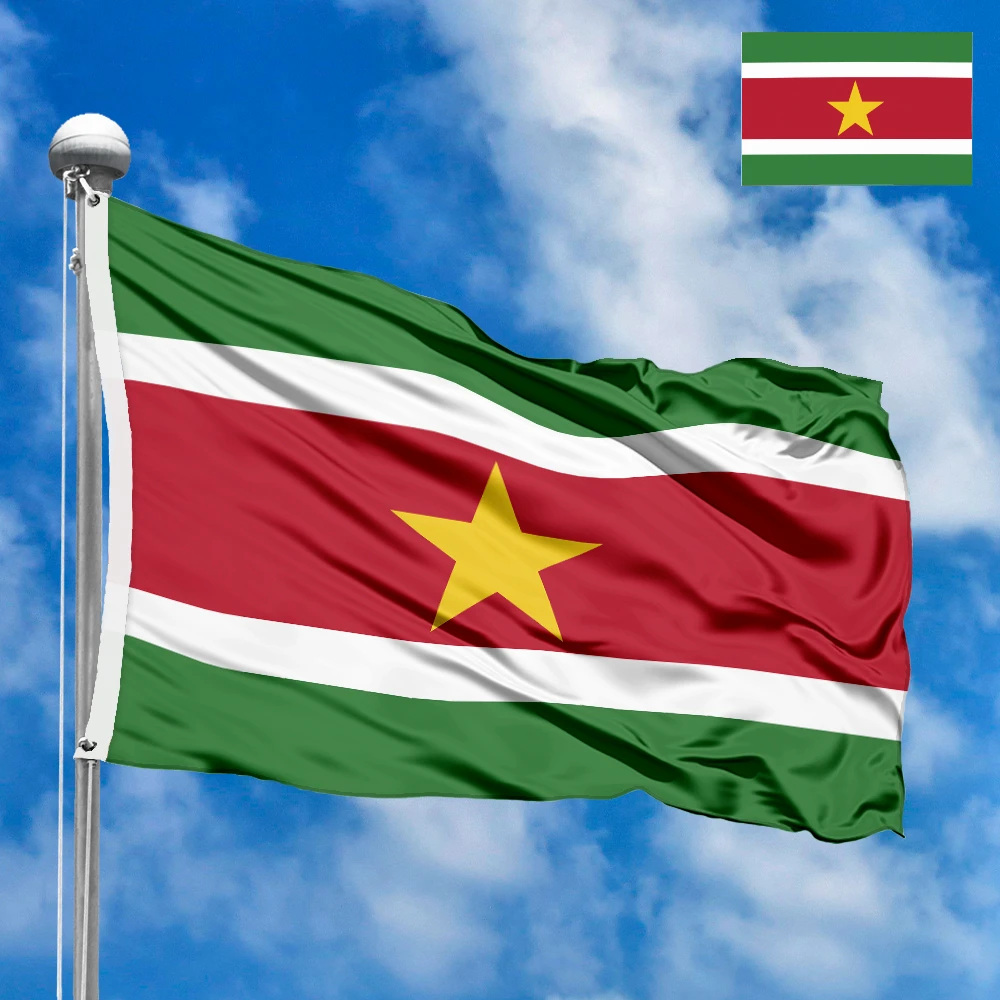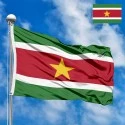The flag of Suriname is a modern and powerful symbol that embodies the country's unique history, multi-ethnic diversity, and aspirations for prosperity. Adopted on Independence Day, November 25, 1975, it replaced the colonial flag and became a reflection of Suriname's new, independent path. The flag's design, rich with deep symbolism, tells a story of national unity, freedom, and hope.
A Detailed Look at the Flag's Design and Symbolism
The national flag of Suriname is composed of five horizontal stripes of varying widths. The top and bottom stripes are green, the stripes between them are white, and the central stripe is red. The central red stripe is wider than the white and green ones. In the center of the flag, superimposed on the red stripe, is a large, five-pointed yellow star. This specific arrangement and coloring are the result of a national competition held prior to independence.
Each color and element on the flag carries a distinct and profound meaning, representing the core values and aspirations of the Surinamese people:
-
Green Stripes: The two green stripes, located at the top and bottom, symbolize the fertile soil and abundant natural resources of Suriname. They represent the agricultural wealth of the country, as well as the dense forests and grasslands. More importantly, green symbolizes hope for a better, more prosperous future. It is a color that speaks to the nation's optimism and belief in its potential.
-
White Stripes: The two white stripes, separating the green and red stripes, represent justice, freedom, and the peace that has been fought for and achieved. They symbolize the honesty and integrity of the people, as well as their commitment to a just and equitable society. The white color is a reminder of the peace that unites the country's diverse population.
-
Red Stripe: The central red stripe represents the struggle for independence and the dynamic, progressive nature of the Surinamese people. It symbolizes the blood shed in the fight for freedom and the unwavering determination of the nation to build a better life. Red is a color of energy, passion, and the love that unites the people, regardless of their background.
-
The Yellow Star: The large, five-pointed yellow star in the center of the flag is the most significant symbol. Its golden color represents the golden future that awaits the country. The star symbolizes unity, sacrifice, and the bright beacon of hope for the nation.
-
Five Points: The five points of the star are particularly meaningful. They represent the five major ethnic groups that make up the Surinamese population: the indigenous peoples, the Creoles, the Hindustanis (East Indians), the Javanese, and the Maroons. The fact that the star is a single, unified symbol at the heart of the flag emphasizes that all these groups are united and working together towards a shared, prosperous future. It is a powerful message of unity in a nation known for its cultural diversity.
The History and Adoption of the Flag
The history of the Surinamese flag is directly tied to the country's political evolution from a Dutch colony to an independent nation. Before 1975, Suriname had a different flag, adopted in 1959, when it became an autonomous part of the Kingdom of the Netherlands. That flag was white with a black oval in the center, which contained five colorful, linked stars representing the different ethnic groups.
As the country moved closer to full independence, a new national symbol was needed. A design competition was held to create a flag that would better represent the new, unified, and sovereign nation. The winning design was a radical departure from the colonial flag. The complex, linked stars were replaced by a single, powerful star, symbolizing the new unity of the people.
The current flag was officially adopted on November 25, 1975, the very day Suriname gained full independence from the Netherlands. This timing is crucial, as it makes the flag an inseparable part of the nation's independence celebration and its new identity.
Meaning and Significance for Residents
For the people of Suriname, the flag is more than just a national emblem; it is a testament to their shared history and a symbol of their collective future. It represents the successful journey from a multi-ethnic colony to a unified, self-governing nation. The flag’s vibrant colors and the prominent golden star serve as a constant reminder of the hard-won freedom and the importance of national unity. It is a source of immense pride, especially during national holidays and cultural events. The flag embodies the spirit of a people who have overcome historical divisions to build a new, inclusive society, united by a common hope for progress and prosperity.
Interesting Facts
-
The current flag was not the first one. The flag used from 1959 to 1975 featured a white field with five stars of different colors connected by an elliptical ring, a symbol of the different ethnic groups coexisting.
-
The proportional widths of the stripes are officially designated as follows: green stripes are 2/8 of the flag's height, white stripes are 1/8, and the red stripe is 3/8.
-
The golden star in the center is meant to be a beacon of hope, guiding the nation toward a better future. The specific shade of yellow is often described as "golden" to emphasize the value of the nation's future.
-
The flag's design was chosen to be simple, memorable, and full of meaning, a deliberate contrast to the more complex and politically fraught design of the previous flag.
-
The red stripe, symbolizing the struggle, is the widest, highlighting the importance of the sacrifices made for independence and the energy and passion that still drives the nation.
In the demonstration images, full-size flags are shown with proportions of 2:3, and hand-held flags with proportions of 1:2.






 Waving flag
Waving flag
 Sizes:
Sizes:
 Round flag
Round flag
 Sizes:
Sizes:
 Rectangular flag 2:3
Rectangular flag 2:3
 Sizes:
Sizes: